The AMD 2nd Gen Ryzen Deep Dive: The 2700X, 2700, 2600X, and 2600 Tested
by Ian Cutress on April 19, 2018 9:00 AM ESTPrecision Boost 2 and XFR2: Ensuring It Hertz More
One of the biggest changes for the new Ryzen-2000 series is in how the processor implements its turbo. Up until this point (except the recent APU launch), processors have relied on a step function implementation: the system determines how many threads are loaded, attempts to implement a specific frequency on those cores if possible, and then follows the look-up table relating thread count to frequency. AMD’s goal in Precision Boost 2 is to make this process more dynamic.
This image from AMD is how the feature is being represented: the system will determine how much of the power budget is still available, and turbo as much as possible until it hits one of the limiting factors. These factors can be any of, but not limited to, the following:
- Total chip peak power
- Individual core voltage/frequency response
- Thermal interactions between neighboring cores
- Power delivery limitations to individual cores/groups of cores
- Overall thermal performance
AMD’s new Ryzen Master 1.3 software, when used on a Ryzen 2000-series processor, has several indicators to determine what the limiting factors are. For the most part, the way the processor will boost and respond to the environment, will be transparent to the user.
The best way to test this in action, from my perspective, is to look at the power draw of the first generation and second generation Ryzen processors. We can examine the internal estimated power consumption of each core individually as thankfully AMD has left these registers exposed, to give the following data:
This is only the core consumption power, not the package power, which would include the DRAM controller, the Infinity Fabric, and the processor IO. This means we get numbers different to the rated TDP, but the danger here is that because the Ryzen 7 2700X has a 10W TDP higher than the Ryzen 7 1800X, where the 2700X draws more power it could seem as if that is the TDP response.
Just plotting the power consumption gives this graph:
Even in this case it is clear that the Ryzen 7 2700X is drawing more power, up to 20W more, for a variable threaded load. If we change the graph to be a function of peak power:
The results are not quite as clear: it would seem that the 1800X draws, as a percentage of peak power, more at low thread count, but the 2700X draws more at a middling thread count.
It is worth noting that the end result of Precision Boost 2 is two-fold: more performance, but also more power consumption. Users looking to place one of the lower powered processors into a small form factor system might look at disabling this feature and returning to a standard step-function response in order to keep the thermal capabilities in check.
A side note – despite the marketing name being called ‘Precision Boost 2’, the internal BIOS name is called ‘Core Performance Boost’. It sounds similar to Multi-Core Enhancement, which is a feature on some Intel motherboards designed to go above and beyond the turbo mechanism. However, this is just AMD’s standard PB2: disabling it will disable PB2. Initially we turned it off, thinking it was a motherboard manufacturer tool, only to throw away some testing because there is this odd disconnect between AMD’s engineers and AMD’s marketing.
Extended Frequency Range 2 (XFR2)
For the Ryzen 2000-series, AMD has changed what XFR does. In the previous generation it was applied on certain processors to allow them to boost above the maximum turbo frequency when the thermal situation was conducive to higher frequencies and higher voltage in low thread-count states. For this generation, it still relates to thermals, however the definition is applied to any core loading: if the CPU is under 60ºC, the processor can boost no matter what the loading is above its Precision Boost 2 frequency (so why not get a better PB2 implementation?). The core still has to be within a suitable voltage/frequency window to retain stability, however.
On certain motherboards, like the ASUS Crosshair VII Hero, there are additional options to assist XFR2 beyond AMD’s implementation. ASUS does not go into specific details, however I suspect it implements a more aggressive version, perhaps extending the voltage/frequency curve, raising the power limits, and/or adjusting the thermal limit.


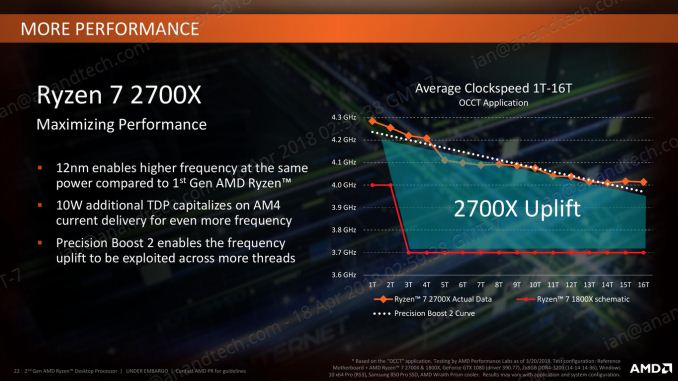
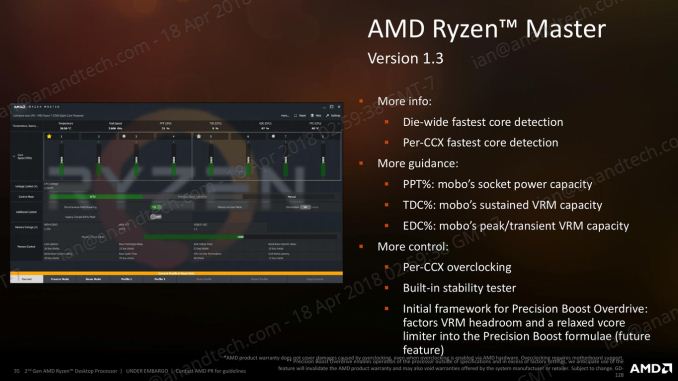

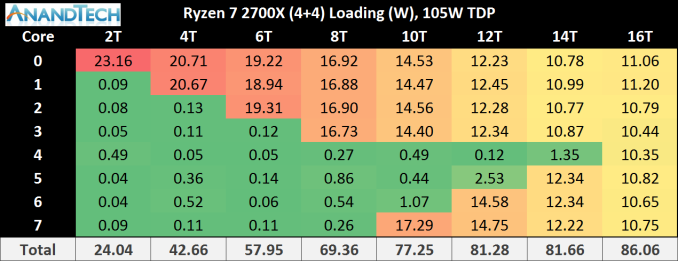
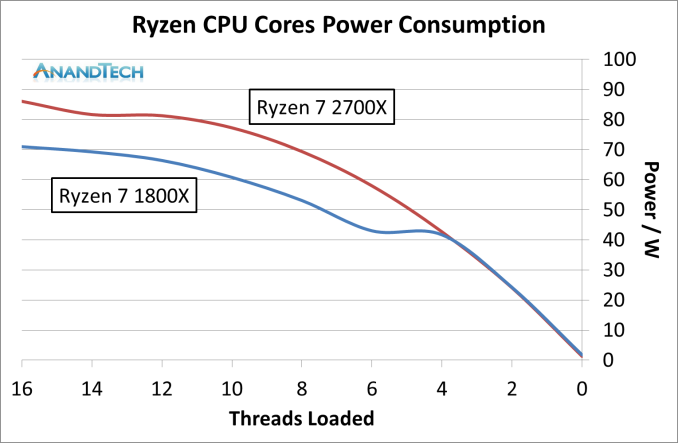
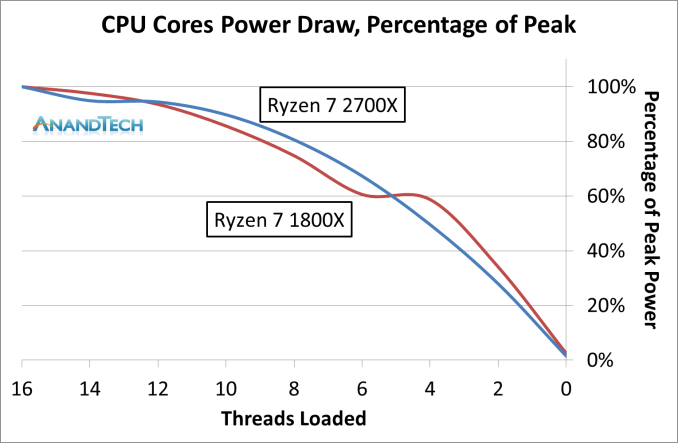
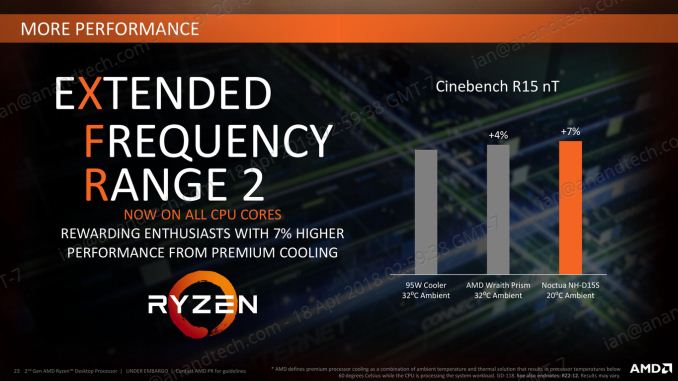








545 Comments
View All Comments
peevee - Thursday, April 26, 2018 - link
I mean, Octane test in Chrome is what V8 javascript compiler does. And it itself is build with MSVC AFAIR.Dragonstongue - Thursday, April 26, 2018 - link
just looking back at this, you say according to title 2700x-2700-2600x-2600 and yet in most tests are only listing the results for 2700x-2600x..not good for someone really wanting to see the differences in power use or performance comparing them head to head sort of speak.seems the 2700 would be a "good choice" as according to the little bit of info given about it, it ends up using less power than the 2600 even though rated same TDP with 2 extra core 4 extra threads O.O
I do "hope" the sellers such as amazon at least for us Canadian folk stick closer to the price they should be vs tacking on $15-$25 or more compared to MSRP pricing, seems if one bought them same day of launch pricing was right where it should be.
1600 has bounced around a little bit whereas 1600x is actually a fair price compared to what it was "very tempting" though the lack of a boxed cooler is not good.....shame 2600 only comes with wraith stealth instead of spire seeing as the price is SOOO close (not to mention at least launch price vs what the 1xxx generation is NOW, AMD should have been extra nice and bundled the wraith spire for 2600-2600x and wraith LED and wraith max or whatever for the 2700-2700x
I would imagine if they decide to do a 4 core 8 thread 2xxx that would be the spot to use the wraith spire (less heat load via less cores type deal)
29a - Thursday, April 26, 2018 - link
Not trying to be sarcastic but will this article be finished? I really wanted to read the storage and chipset info. If the article is as complete as it is going to get please let us know, 20 year reader asking.John_M - Saturday, April 28, 2018 - link
I'm sure it will be finished one day but I agree that it doesn't seem so at the moment. If you want to find out about StoreMI AMD has a page about it: https://www.amd.com/en/technologies/store-miET - Tuesday, May 1, 2018 - link
I think we've got ourselves a race: which will get here first, the missing parts of the 2nd gen Ryzen review, or new Raven Ridge drivers? Or perhaps hell will freeze first.29a - Friday, May 4, 2018 - link
Sadly it appears as though the article will not be finished. This site was great during about its first 15 years of existence, Purch has done a thorough job of purching it up.jor5 - Tuesday, May 8, 2018 - link
Oh dear what an embarrassing end to this article.Tuck it away under "what was I thinking??" and pretend it never happened.
x0fff8 - Wednesday, May 9, 2018 - link
is this article ever gonna get updated with the new benchmarks?MDD1963 - Thursday, May 10, 2018 - link
And just like that, my 7700K is fast again! :)peevee - Thursday, May 10, 2018 - link
"Technically the details of the chipset are also covered by the April 19th embargo, so we cannot mention exactly what makes them different to the X370 platform until then"That was written for the article published April 19th, and as of May 10th STILL in the text.